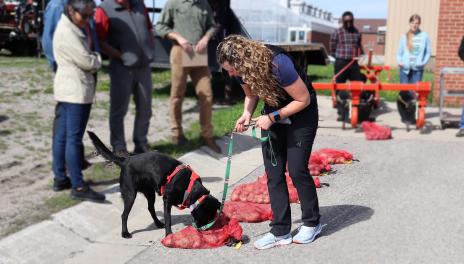Potato diseases are going to the dogs
Dogs are known for their keen sense of smell and are regularly used to detect explosives, illegal drugs and illness. It turns out they also can be trained to sniff out plant diseases. In May, North Dakota State University (NDSU) potato breeder Asunta “Susie” Thompson hired Andrea Parish, owner of Nose Knows Scouting, and her Labrador, Zora, to evaluate the potato breeding project’s certified seed potato tubers for Potato Virus Y (PVY). PVY causes yield loss and tuber defects and is a significant problem for certified seed potato growers.
Parish, who previously worked as a physical therapist, started her business about three years ago in Wyoming. She loves dogs and says, “Dogs are used to detect bombs, drugs and other substances in mail sorting centers and airports, and I thought they would be useful on farms, too.” She asked her potato crop consultant husband if farmers are using dogs to detect diseases in potatoes. She was surprised when he said “no.”
“Although governments have spent millions of dollars trying, you can’t replace a dog’s nose,” Parish says. “It’s still the most accurate means of scent detection.”
Parish learned more about potato diseases from Neil Gudmestad, retired NDSU University Distinguished Professor of Plant Pathology and Endowed Chair of Potato Pathology, and by attending potato grower conferences. She learned to train dogs from top U.S. law enforcement officials including FBI and drug detection dog trainers. Currently, she has five dogs trained to detect potato diseases. She started with PVY, and more recently began training dogs to detect Bacterial Ring Rot (BRR).
Zora is a five-year-old black Labrador retriever who loves to work. She could be heard barking while on break, eager to get back to work. She can detect PVY in tuber samples and young plants in the field. Zora’s reward for properly signaling that she has detected PVY is a tennis ball tossed in the air for her to catch. You can’t beat that for employee compensation. Of course, Zora also receives room and board.
Parish’s dogs often come from animal shelters. She says that “floppy-eared” dogs such as Labradors and spaniels are a good fit for this type of work because they are high-energy, high-drive dogs that thrive on mental stimulation. “They like the brain work,” Parish says. “It’s like a big puzzle for them to figure out.”
The training process involves “giving the odor value” through positive reinforcement, which can be different for each dog. Commands are given in Dutch because the law enforcement dog trainers Parish works with use Dutch commands.
A full day's work for the dogs is about four to five hours with rest periods throughout. Parish must carefully manage their time on task because, just like humans, detection dogs can become less accurate when they are tired.
When Parish is examining potato tubers, she brings one dog to check the samples. When she is hired for a larger job, such as scouting fields, she uses multiple dogs, each with a trainer, and they take turns running sections of the field for about 20 minutes at a time.
Parish and Zora evaluated the NDSU potato breeding program’s entire collection of germplasm, which includes 1,000 different genotypes, in less than a day. First, Parish and Zora walked through the potato cold storage room and checked the lower shelves. Then, potato breeding team members brought bags of tubers out of the cold storage room and laid out eight to ten bags on the floor at a time. Parish led Zora by each bag and Zora pawed through the bags to sniff every tuber. When Zora detected PVY, she stood alert with her nose on the suspicious bag until Parish gave her the signal to release. The bags that Zora flagged were pulled aside to recheck later.
After all the bags were checked, individual tubers from the flagged bags were separated out and Zora identified the specific tubers that were positive for PVY. Finally, the storage room was rechecked. After the entire process, only certified seed potato tubers free from PVY remained to plant the next generation of the breeding lines.
Thompson says if the detection dog method is as accurate as laboratory testing for PVY, it could save the breeding project a significant amount of labor, time and resources. “What we tested this morning with the dog would have taken us three months in the greenhouse and lab,” she says.
Laboratory testing for PVY is a time-consuming and labor-intensive process because of the high volume of tests that must be prepared by the potato breeding staff and processed by the lab. In addition, valuable greenhouse space would be better used to screen potential new varieties than to detect and eliminate PVY in existing plant materials. Disease identification by detection dogs would help shorten the breeding process, allowing new potato varieties to be developed more quickly and benefiting potato producers sooner.
Thompson is looking forward to learning if the tubers that Zora identified as positive for PVY are confirmed in the laboratory. If the dog’s results are accurate, Thompson says that in the future, “I would hire [Nose Knows Scouting to scout for PVY] because of the economics and time savings.” She envisions Parish visiting the program in the winter or early spring, to evaluate the seed material before planting, and again during the summer, to scout field research plots.
Sources: Asunta Thompson, Andrea Parish
Author: Kamie Beeson
Editor: Karen Hertsgaard
